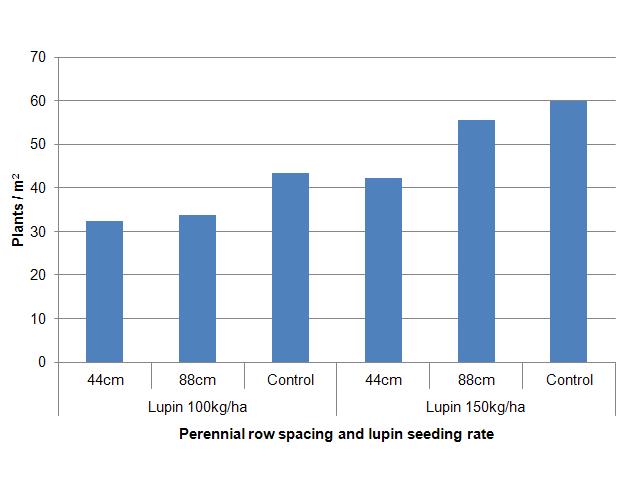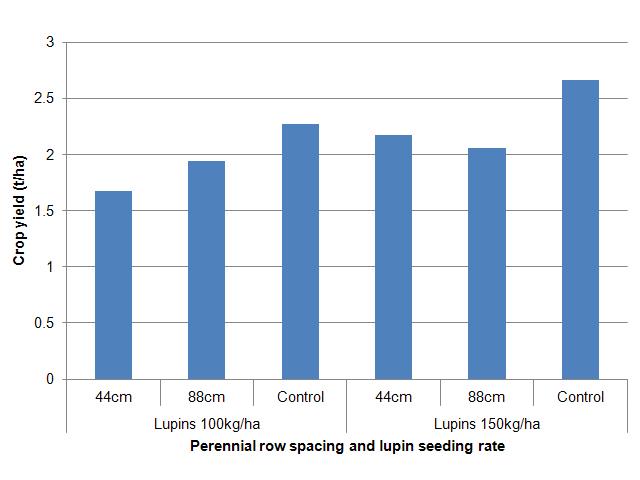Background
Pasture cropping for grain (seeding an annual crop over a live perennial pasture) has proved to be viable at a focus site south west of Moora over the past four years (Ward et al. 2012) and herbicide options that control crop weeds without jeopardising the persistence of the perennial base have been identified (Borger J and Ferris D 2013) Tolerance of subtropical grasses to in-crop grass selective herbicides during winter. Agribusiness Crop Updates, 25-26 February 2013, Crown Perth).
However, information on other management issues, such as crop seeding rate and options for growers without disc seeders, are being sought by innovative growers to help refine pasture cropping systems.
Aim
To evaluate the impact of crop seeding rate and perennial row spacing on grain yield of lupin crops.
To evaluate the feasibility of using tine seeders fitted with precision guidance technology to sow annual crops into sub-tropical perennial pastures (offset to perennial rows) without damaging the perennial base.
Trial details
| Property | Peter Negus, 20km south of Dandaragan |
|---|---|
| Soil type | Deep sand; soil surface (0-10cm) pH (CaCl2) 5.4, organic carbon 1.06% |
| Crop/variety | Gunyidi lupin sown into established Gatton panic grass plots |
| Paddock rotation | Permanent volunteer pasture (dominated by ryegrass and capeweed) until sown to Gatton panic grass in September 2012. |
| Key treatments | 100kg/ha lupin sown over panic rows 44cm apart 100kg/ha lupin sown over panic rows 88cm apart 100kg/ha lupin (annual control) 150kg/ha lupin sown over panic rows 44cm apart 150kg/ha lupin sown over panic rows 88cm apart 150kg/ha lupin (annual control) |
| Replicates | Three |
| Sowing date | 24 May 2013 |
| Seeding rate | 100 or 150kg/ha |
| Fertiliser (kg/ha) | Super Potash 3:1 (160kg/ha) |
| Herbicides | 24 May 2013: Knockdown of Sprayseed 1L/ha, Treflan 1.5L/ha, Simazine 1.5L/ha 2 July 2013: Grass selective (Select 500mL/ha) to control ryegrass and suppress Gatton panic. |
| Growing season rainfall | 529mm (May to October) 113mm of summer rainfall (January to April) resulted in ~1t/ha perennial growth prior to seeding. |
Results
Perennial pasture base
Gatton panic establishment was about six plants per metre of row (April 2013) and perennial biomass (20 May 2013) just prior to the seeding the lupin crop averaging 720-1000kg/ha.
Very few perennial plants were damaged (pulled up by tines) when pasture crops were sown with a DPIRD cone seeder fitted with narrow points, DGPS (+/- 2cm accuracy) and autosteer.
Lupin density and yield
Lupin density in the control treatments (no perennial base) was 43 plants/m2 for the 100kg/ha seeding rate and 60 plants/m2 for the 150kg/ha seeding rate (Figure 1).
By comparison, crop establishment was 8-30% lower for pasture cropped treatments.
Notwithstanding, the impact of the perennial base on lupin establishment appeared to be moderated by wide (88cm) perennial rows.
Increasing seeding rate from 100-150kg/ha increased grain yield across all treatments (Figure 2).
Grain yield for the control (no perennial base) seeded at 100kg/ha was 2.3t/ha.
Grain yield for pasture crops seeded at the same rate were 26% and 17% less for crops sown over narrow (44cm) and wide (88cm) panic rows respectively.
There was also a yield penalty for pasture crops sown at 150kg/ha (19-22%).
Conclusion
Crop seeding rate and perennial row spacing both influence grain yield of pasture crops.
Lifting seeding rate of pasture crops might compensate for poorer establishment and in turn, help to reduce any grain yield penalty.
For this experiment, assuming lupin seed is $300/t, lifting seeding rate by 50kg/ha ($15) helped to avert a 26% yield penalty and proved to be $165/ha more profitable overall.
Where growers do not own a disc machine but have invested in precision guidance technology, with forward planning, it is feasible to use a tined machine to sow crops into perennial pastures without damaging the perennial base.
Acknowledgements
Thanks go to Daisy and Peter Negus for hosting the trial and the DPIRD Geraldton Research Facility staff for sowing and managing the trial.
This research is being supported by the Caring for Our Country project Transforming the Northern Sandplain and GRDC through the Future Farm Industries Cooperative Research Centre Ltd’s EverCrop project (P2 FP09).


